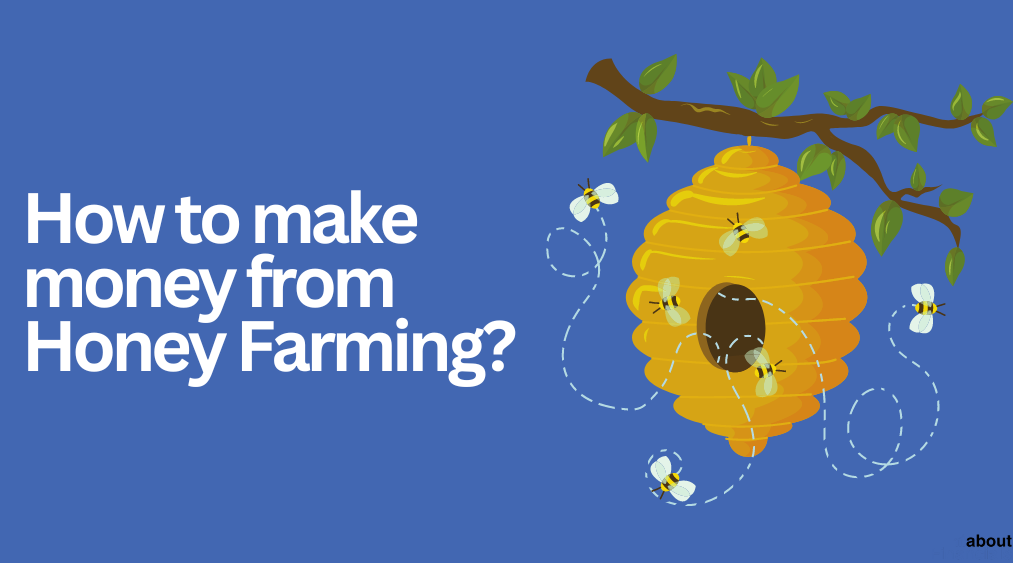To make a living from honey, you need to have around 560 beehives.
The number of bee hives required to make a living can vary and based on several factors. However, let’s consider some general estimates and calculations to give you an idea.
Honey production is the primary source of income for many beekeepers. On average, a healthy and well-managed hive can produce around 40-80 pounds of honey per year. This estimate can vary depending on local conditions, beekeeping practices, and the strength of the colony.
Honey prices also vary depending on the region and market demand. In US, a conservative average selling price is $3 per pound of honey.
To achieve a target income of $100,000 per year, you need to divide that amount by the estimated annual honey revenue per hive.
Let’s use an average estimate of 60 pounds of honey per hive. This means each hive can potentially generate $180 (60 pounds x $3 per pound) in annual honey revenue.

Final answer to how many bee hives to make a living
$100,000 (target annual income) ÷ $180 (annual honey revenue per hive) = 555 bee hives
Keep in mind that this calculation is based solely on honey production as the revenue source. It does not consider other potential income streams such as bee-related products, pollination services, agri-tourism, or value-added items. Diversifying your revenue sources can contribute to reaching your income goals more effectively.
In the following article, we will explore actionable steps and strategies that can help you unlock the full potential of honey farming and turn your passion into a profitable venture.
26 ways to maximize your earning potential in honey farming
1. Beekeeping know-how
Embarking on a successful beekeeping journey begins with arming yourself with the right knowledge and honing essential skills. Dive into books, online resources, and local workshops to grasp the fundamentals of beekeeping.
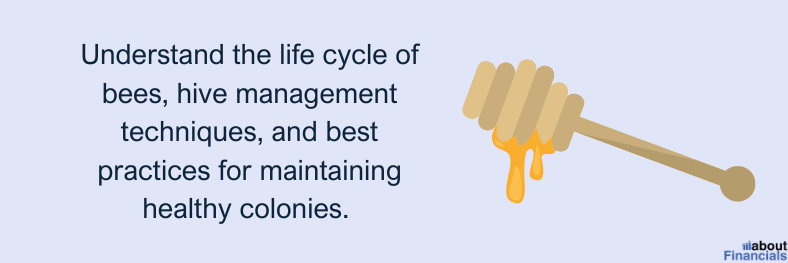
Understand the life cycle of bees, hive management techniques, and best practices for maintaining healthy colonies. By equipping yourself with this valuable knowledge, you’ll be ready to tackle the challenges and reap the rewards of beekeeping.
2. Finding the perfect spot for your bee hives
Bees thrive in specific environments, so choosing the right spot for your bee hives is crucial.

Seek out areas with abundant nectar and pollen sources, away from potential pesticides and pollutants.
Additionally, consider factors such as access for maintenance, proximity to water sources, and favorable microclimates. By providing an ideal setting for your bees, you lay the foundation for a thriving business.
3. Selecting the perfect bees
Research and consult local experienced beekeepers to identify the bee species that are best suited for your region.
Factors such as temperature tolerance, disease resistance, and honey production potential should guide your decision.
By selecting the right bee species, you ensure that your hives flourish and maximize their potential for honey production and pollination services.
4. Setting the stage for success
To transform the golden nectar from your hives into a profitable commodity, you need to set up honey extraction equipment.
Invest in a quality honey extractor, uncapping knife, strainers, and storage containers. Ensure your extraction area is clean and well-ventilated to maintain the purity and quality of your honey.
5. Harvesting honey at the perfect moment
Patience pays off in the beekeeping world, especially when it comes to harvesting honey.
Wait for the right time when the honey frames are capped, indicating that the honey is ripe and ready for extraction.
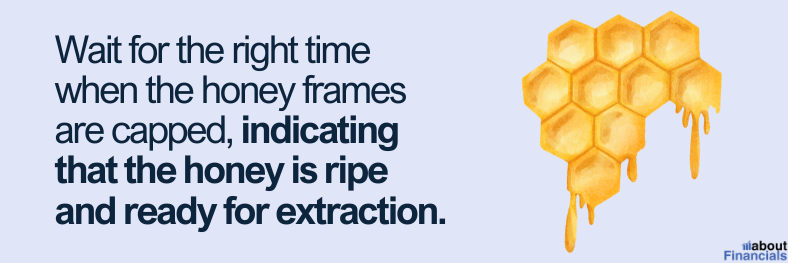
Consult local experts or experienced beekeepers to determine the optimal harvest time based on your bee species and local climate.
By harvesting at the perfect moment, you capture the full flavor and quality of your honey, enhancing its market value.
6. Packaging and labeling
Invest in eye-catching and eco-friendly packaging materials that reflect the premium nature of your product.
Craft informative and visually appealing labels that showcase the origin, floral source, and unique qualities of your honey.
By capturing customers’ attention and providing them with essential details, you make your honey stand out from the swarm.
7. Establishing distribution channels
To maximize the reach of your honey, establish diverse distribution channels.
Explore local markets, farm stands, and specialty stores to cater to customers seeking fresh, locally sourced products.
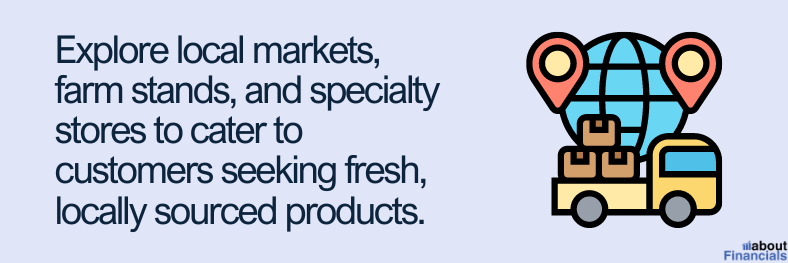
Embrace the digital era by leveraging online platforms and e-commerce websites to reach a wider audience.
Collaborate with restaurants, cafes, and gourmet shops that value quality honey. By tapping into multiple distribution channels, you ensure a steady flow of customers buzzing towards your honey.
8. Creating a brand
Building a strong brand presence and implementing effective marketing strategies is key to honey sales success.
Develop a compelling brand story that highlights your commitment to sustainable beekeeping and the unique qualities of your honey.
Utilize social media platforms, create engaging content, and collaborate with influencers to generate buzz around your product.
Participate in local events, farmers’ markets, and food festivals to let people taste and experience the excellence of your honey firsthand.
By employing smart marketing strategies, you turn your honey into a coveted and sought-after delight.
9. Pollination services
When it comes to the growth and abundance of our crops, bees play a vital role as nature’s diligent pollinators.
Their buzzing wings carry pollen from flower to flower, enabling plants to bear fruit and seeds.
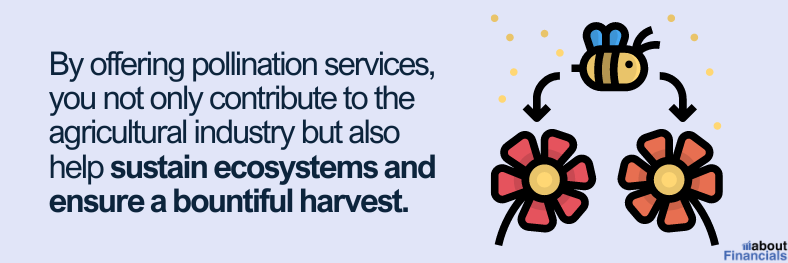
By offering pollination services, you not only contribute to the agricultural industry but also help sustain ecosystems and ensure a bountiful harvest.
Understanding and highlighting the importance of bees in pollination will emphasize the value of your services to potential clients.
10. Pollination partnership
Forge fruitful partnerships with farmers and orchard owners who rely on pollination for their crops’ success.
Connect with local agricultural communities, attend farmers’ markets, and engage in networking opportunities to establish relationships. Understand their specific pollination needs and offer tailored services that align with their crop requirements.
By becoming their trusted pollination partner, you contribute to their productivity and, in turn, boost your business.
11. Pricing pollination
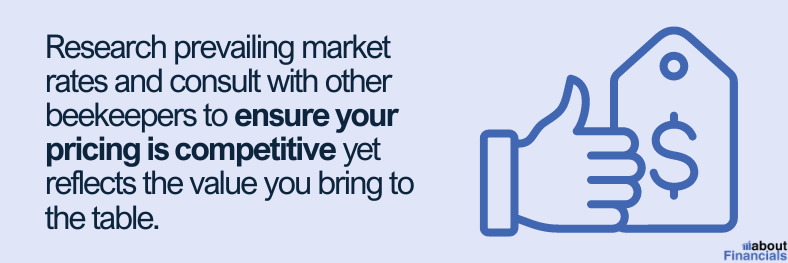
Determining the pricing for your pollination contracts requires careful consideration.
Factors such as the size of the area to be pollinated, the density of hives needed, and the specific crop requirements should influence your pricing strategy.
Research prevailing market rates and consult with other beekeepers to ensure your pricing is competitive yet reflects the value you bring to the table.
Strive for a fair deal that benefits both parties and fosters long-term partnerships.
12. Nurturing client connections
Communicate regularly and proactively with farmers and orchard owners, providing updates on hive health, progress, and any insights or recommendations.
Address any concerns or challenges promptly and professionally. Going extra mile by offering educational resources or hosting workshops on pollination-related topics can strengthen your client relationships and showcase your expertise.
With building trust and demonstrating your commitment to their success, you become the go-to partner for their pollination needs.
13. Value-added bee products
Beekeeping offers a world of possibilities beyond honey.
Beeswax, a versatile substance produced by bees, can be transformed into an array of delightful products.
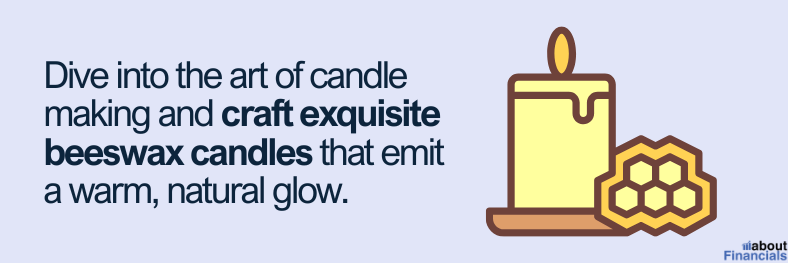
Dive into the art of candle making and craft exquisite beeswax candles that emit a warm, natural glow. Venture into the realm of cosmetics, creating lip balms, lotions, and soaps that harness the nourishing properties of beeswax.
With a touch of creativity and craftsmanship, you can turn beeswax into sought-after treasures that delight customers and diversify your product line.
14. Bee pollen, propolis, and royal jelly
Explore the hidden gems within the hive—bee pollen, propolis, and royal jelly.
Harvest bee pollen, a nutrient-rich superfood, and offer it to health-conscious customers looking to boost their well-being.
Collect propolis, a resinous substance with antimicrobial properties, and market it as a natural health supplement or ingredient.
Extract royal jelly, the queen bee’s food, known for its potential health benefits, and package it as a high-end dietary supplement.
Tapping into these unique bee products, you expand your offerings and cater to a broader market.
15. Specialized honey products
Honey itself can be a canvas for creativity and innovation.
Consider venturing into specialized honey products that cater to different tastes and preferences. Infuse honey with natural flavors such as lavender, cinnamon, or citrus to create delectable varieties that tantalize the palate.
Explore the medicinal properties of honey and develop products targeting specific health needs, such as immune-boosting or allergy-alleviating honey blends. By embracing the versatility of honey, you can captivate niche markets and provide customers with unique and enticing options.
16. Bee hive rental services
Open up a world of possibilities by offering bee hive rental services to individuals or businesses.
Rent out fully functioning hives, complete with bees, to aspiring beekeepers who want to experience the joys of beekeeping without the initial investment.
Provide them with guidance, support, and necessary equipment to ensure a successful beekeeping experience.
Democratizing beekeeping through rental services, you empower others to join the bee-loving community and expand your business reach.
16. Beekeeping knowledge
Share your passion for beekeeping and cultivate a new generation of bee enthusiasts by offering workshops and courses.
Design comprehensive programs that cater to beginners and advanced learners alike. Cover topics such as hive maintenance, bee behavior, honey extraction, and sustainable beekeeping practices. Provide hands-on experiences in a safe and controlled environment, allowing participants to connect with the fascinating world of bees.
By imparting your knowledge and skills, you not only contribute to beekeeping education but also establish yourself as a trusted authority in the field.
17. Making an impact

Local events, fairs, and exhibitions present opportunities to educate the public about the importance of bees and beekeeping.
Participate in these community gatherings to raise awareness and showcase the wonders of the hive. Set up interactive displays, live demonstrations, and educational materials to engage visitors of all ages. Offer tastings of your delicious honey and let the flavors speak for themselves.
Actively participating in local events, you become an advocate for bees, create meaningful connections, and generate interest in your beekeeping services and products.
18. Immersive learning in beekeeping
Step into the world of agri-tourism and create unique opportunities for visitors to learn about beekeeping.
Offer interactive experiences where participants can don a beekeeper suit, get up close and personal with the hives, and gain hands-on knowledge about beekeeping practices.
Share fascinating insights about the life of bees, their role in the ecosystem, and the process of honey production. Providing immersive learning experiences, you ignite curiosity and foster a deeper appreciation for the world of bees.
19. On-site store or farm stand
Extend the Agri-tourism experience by setting up an on-site store or farm stand. Offer a range of bee-related products, including your own honey, beeswax candles, bee pollen, and more.
Create an inviting space where visitors can browse and purchase these delightful offerings. Showcase the uniqueness and quality of your products, emphasizing their connection to the bees and the natural world.
By establishing a retail presence, you not only enhance the visitor experience but also generate additional revenue streams for your beekeeping business.
20. Honey tastings
Engage all the senses of your visitors by offering guided tours and interactive experiences that delight and educate.
Take them on a journey through your beekeeping operation, explaining the different stages of honey production and showcasing the hive’s inner workings.
Organize honey tastings, allowing visitors to savor the distinct flavors of various honey types.
Additionally, consider hosting workshops on beeswax candle making or honey-infused culinary creations.
21. Exploring related areas
As your bee hive business thrives, consider diversifying and expanding into related areas that align with your passion for bees.
Explore the world of pollinator garden services, offering expertise in creating bee-friendly gardens that attract and support these essential pollinators.
Additionally, consider developing and selling bee-friendly products, such as native plant seeds, bee houses, or organic fertilizers.
By expanding into these related areas, you broaden your reach, contribute to environmental conservation, and tap into new revenue streams.
22. Collaboration with other beekeepers
Collaboration can be a powerful tool for growth and mutual benefit. Explore collaboration opportunities with fellow beekeepers or agricultural businesses that share your vision and values.

Pool resources, knowledge, and expertise to create synergistic partnerships. Consider joint marketing initiatives, shared distribution channels, or collaborative projects that leverage the strengths of each party involved.
By working together, you can expand your reach, access new markets, and achieve greater success collectively.
23. Market research for emerging trends
Market research is a compass that guides your diversification and expansion efforts.
Stay informed about emerging trends, consumer preferences, and industry developments. Identify gaps in the market and untapped opportunities.
Explore niche markets or growing sectors within the beekeeping industry, such as organic or sustainable honey production.
By conducting thorough market research, you gain valuable insights that shape your strategic decisions and set you on a path towards continued success.
24. Prioritizing healthy bee colonies
The well-being of your bee colonies is not just crucial for their survival, but also for the success of your beekeeping business.
Emphasize the importance of maintaining healthy bee colonies through proactive hive management. Regularly monitor the health of your bees, checking for signs of pests, diseases, or stress.
Implement proper nutrition and hive hygiene practices to ensure robust and thriving colonies. By prioritizing the health of your bees, you lay the foundation for sustainable success.
25. Sustainable beekeeping practices
Sustainable beekeeping practices benefit both the environment and your business.
Foster harmony between your bees and their surroundings by minimizing chemical interventions and adopting organic approaches whenever possible.
Encourage biodiversity by providing diverse forage sources for your bees. Practice responsible hive management, promoting natural behaviors and reducing stress on the colonies.
Embracing sustainability, you contribute to the preservation of pollinators and the resilience of ecosystems.
26. Environmental factors
The world of beekeeping is not without its challenges, but with proactive measures, you can overcome them.
Stay vigilant against common pests and diseases that affect bees, implementing preventive measures and promptly addressing any issues that arise. Be aware of environmental factors that can impact bee health, such as pesticide exposure or habitat loss.
Stay informed about best practices and advancements in bee health management to adapt and respond effectively.
Final thoughts
Whether you choose to focus on honey production, diversify with value-added products, or create fascinating experience through agri-tourism, the possibilities are as abundant as the bees themselves.
Remember, success in honey farming requires a combination of knowledge, skill, perseverance, and adaptability.
Let your passion for honey farming lead you to a world of sweet rewards, both financial and beyond.

